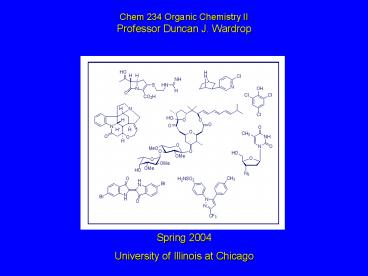Organic Chemistry Fifth Edition - PowerPoint PPT Presentation
1 / 53
Title:
Organic Chemistry Fifth Edition
Description:
Stabilized carbanions, such as those. derived from -diketones undergo conjugate ... formic acid. ethanoic acid. acetic acid. octadecanoic acid. stearic acid ... – PowerPoint PPT presentation
Number of Views:228
Avg rating:3.0/5.0
Title: Organic Chemistry Fifth Edition
1
Chem 234 Organic Chemistry II Professor Duncan
J. Wardrop
Spring 2004
University of Illinois at Chicago
2
19.13Reactions of Carboxylic AcidsA Review and
a Preview
3
(No Transcript)
4
Reactions of Carboxylic Acids
- Acidity (Sections 19.4-19.9)
- Reduction with LiAlH4 (Section 15.3)
- Esterification (Section 15.8)
- Reaction with Thionyl Chloride (Section 12.7)
5
Acidity of Carboxylic Acids
6
(No Transcript)
7
Reactions of Carboxylic Acids
New reactions in this chapter
- ??Halogenation
- Decarboxylation
- But first we revisit acid-catalyzed
esterificationto examine its mechanism.
8
19.14Mechanism of Acid-Catalyzed Esterification
9
Fischer Esterification - A Reversible Process
Acidic Dehydration
Acid Alcohol
Ester Water
Acidic Hydrolysis
10
Mechanism of Fischer Esterification
- The mechanism involves two stages
- 1) formation of tetrahedral intermediate (3
steps) - 2) dissociation of tetrahedral intermediate
(3 steps)
tetrahedral intermediate in esterification of
benzoic acid with methanol
11
Stage One Formation of Tetrahedral Intermediate
- methanol adds to the carbonyl group of the
carboxylic acid - the tetrahedral intermediate is analogous to a
hemiacetal
12
Stage Two Collapse of Tetrahedral Intermediate to
Ester
- this stage corresponds to an acid-catalyzed
dehydration
13
Mechanism of formationoftetrahedral intermediate
14
Step 1
15
Step 1
- carbonyl oxygen is protonated because cation
produced is stabilized by electron delocalization
(resonance)
16
Step 2
17
Step 3
18
Tetrahedral intermediatetoester stage
19
Step 4
20
Step 5
21
Step 5
22
Step 6
23
Key Features of Mechanism
- Activation of carbonyl group by protonation of
carbonyl oxygen - Nucleophilic addition of alcohol to carbonyl
groupforms tetrahedral intermediate - Elimination of water from tetrahedral
intermediate restores carbonyl group
24
Review of Fischer Esterification
25
Industrial Use of Fischer Esterification Polyester
- Dacron
http//www.dupont.com/fiberfill/dacron-main.html
26
A Waste of Good Chemistry
27
19.15Intramolecular Ester FormationLactones
28
Lactones - Cyclic Esters
- Lactones are cyclic esters
- Formed by intramolecular esterification in
acompound that contains a hydroxyl group anda
carboxylic acid function
29
Many Natural Products Contain Lactone Rings
30
Other Lactone Natural Products
Orlistat inhibits dietary fat absorption by 30
(3 x 120 mg)
XENICAL (orlistat) is a lipase inhibitor for
obesity management that acts by inhibiting the
absorption of dietary fats.
http//www.rocheusa.com/products/xenical/pi.html
31
Lactones are Formed From w-Hydroxy Carboxylic
Acids via Esterification
H2O
4-hydroxybutanoic acid
4-butanolide
- IUPAC nomenclature replace the -oic acid ending
of the carboxylic acid by -olide - identify the oxygenated carbon by number
32
Lactonization via Esterification
H2O
4-hydroxybutanoic acid
4-butanolide
33
Lactone Nomenclature
?
?
?
?
?
?
?
?-butyrolactone
?-valerolactone
- Ring size is designated by Greek letter
corresponding to oxygenated carbon - A ? lactone has a five-membered ring
- A ? lactone has a six-membered ring
34
w-Hydroxy Carboxylic Acids Readily Undergo
Lactonization
- Reactions designed to give hydroxy acids often
yield the corresponding lactone, especially if
theresulting ring is 5- or 6-membered.
35
Example
5-hexanolide (78)
36
19.16?-Halogenation of Carboxylic AcidsThe
Hell-Volhard-Zelinsky Reaction
37
a-Halogenation of Carboxylic Acids
X2
HX
- analogous to ?-halogenation of aldehydes and
ketones - key question Is enol content of carboxylic
acids high enough to permit reaction to occur
at reasonable rate? (Answer is NO)
38
But...
P or PX3
X2
HX
- reaction works well if a small amount
ofphosphorus or a phosphorus trihalide is added
tothe reaction mixture - this combination is called the Hell-Volhard-Zelin
sky reaction
39
Example of H.V.Z. Reaction
Br2
PCl3
benzene80C
40
Example of H.V.Z. Reaction
Br2
P
(77)
- Value ?-Halogen can be replaced by
nucleophilic substitution
41
Why is the H.V.Z. Reaction Valuable?
Br2
P
(77)
42
Synthesis of a-Amino Acids via H.V.Z. Reaction
Br2
(CH3)2CHCH2COH
PCl3
(88)
43
19.17Decarboxylation of Malonic Acidand Related
Compounds
44
Decarboxylation of Carboxylic Acids
Simple carboxylic acids do not decarboxylatereadi
ly.
RH
CO2
45
Decarboxylation of Malonic Acid
One carboxyl group assists the loss of the other.
- This compound is the enol form of acetic acid.
46
Decarboxylation of Malonic Acid
One carboxyl group assists the loss of the other.
47
Decarboxylation of Malonic Acid
One carboxyl group assists the loss of the other.
Groups other than H may be present.
R
48
1,3-Dicarboxylic Acids Undergo Decarboxylation
49
Decarboxylation of Substituted Malonic Acids
One carboxyl group assists the loss of the other.
50
Decarboxylation of Substituted Malonic Acids
One carboxyl group assists the loss of the other.
Groups other than OH may be present.
R
51
Mechanism of Decarboxylation
This kind of compoundis called a ?-keto acid.
?
?
- Decarboxylation of a ?-keto acid gives a ketone.
52
Decarboxylation of b-Keto Carboxylic Acids
25C
CO2
53
Information Suggested Problems
Suggested Problems 19.24-19.34 ------------------
----------------------------------------------- Of
fice Hour Thursday, 3.30 P.M., SES
4446 ---------------------------------------------
--------------------































